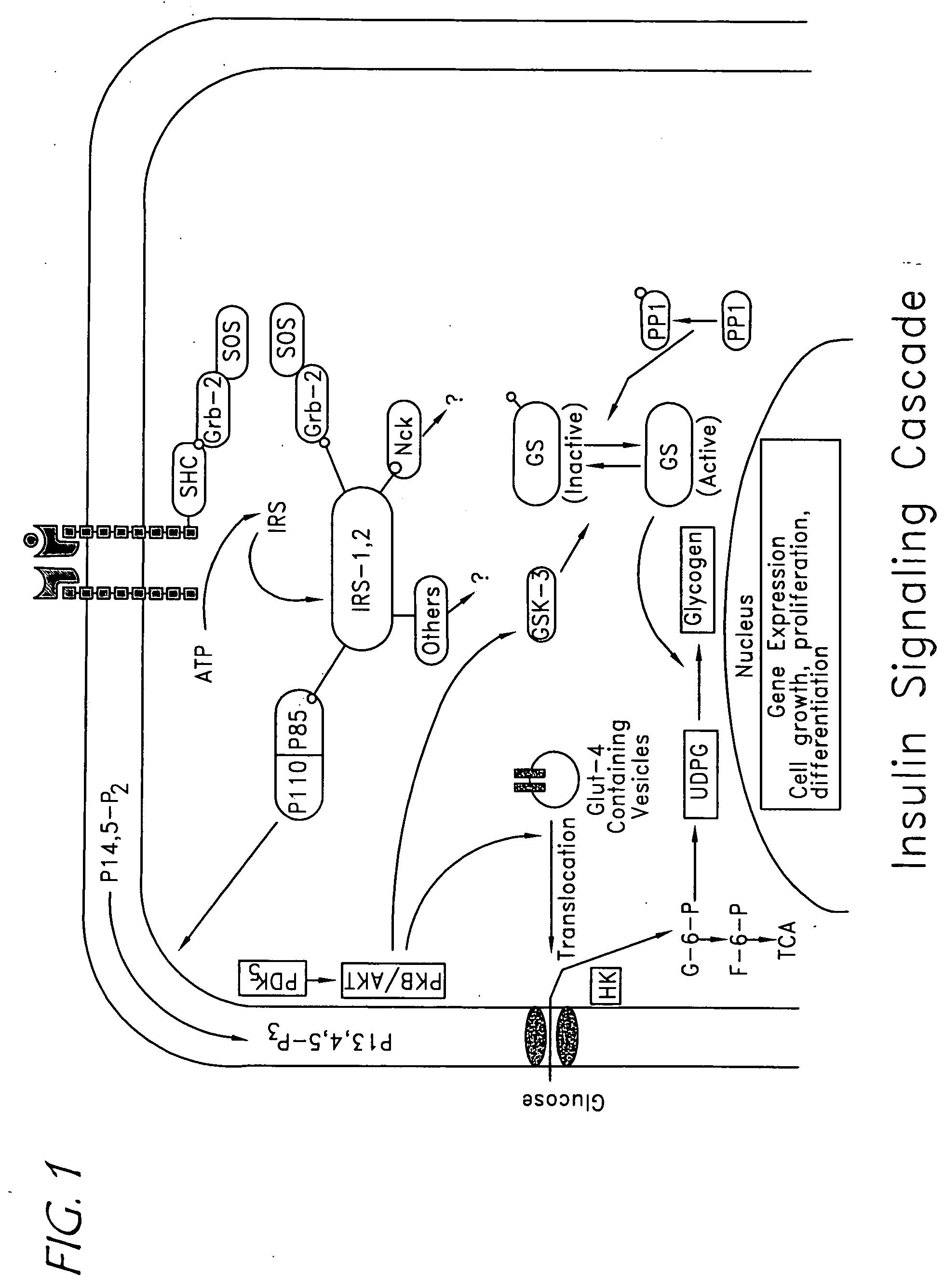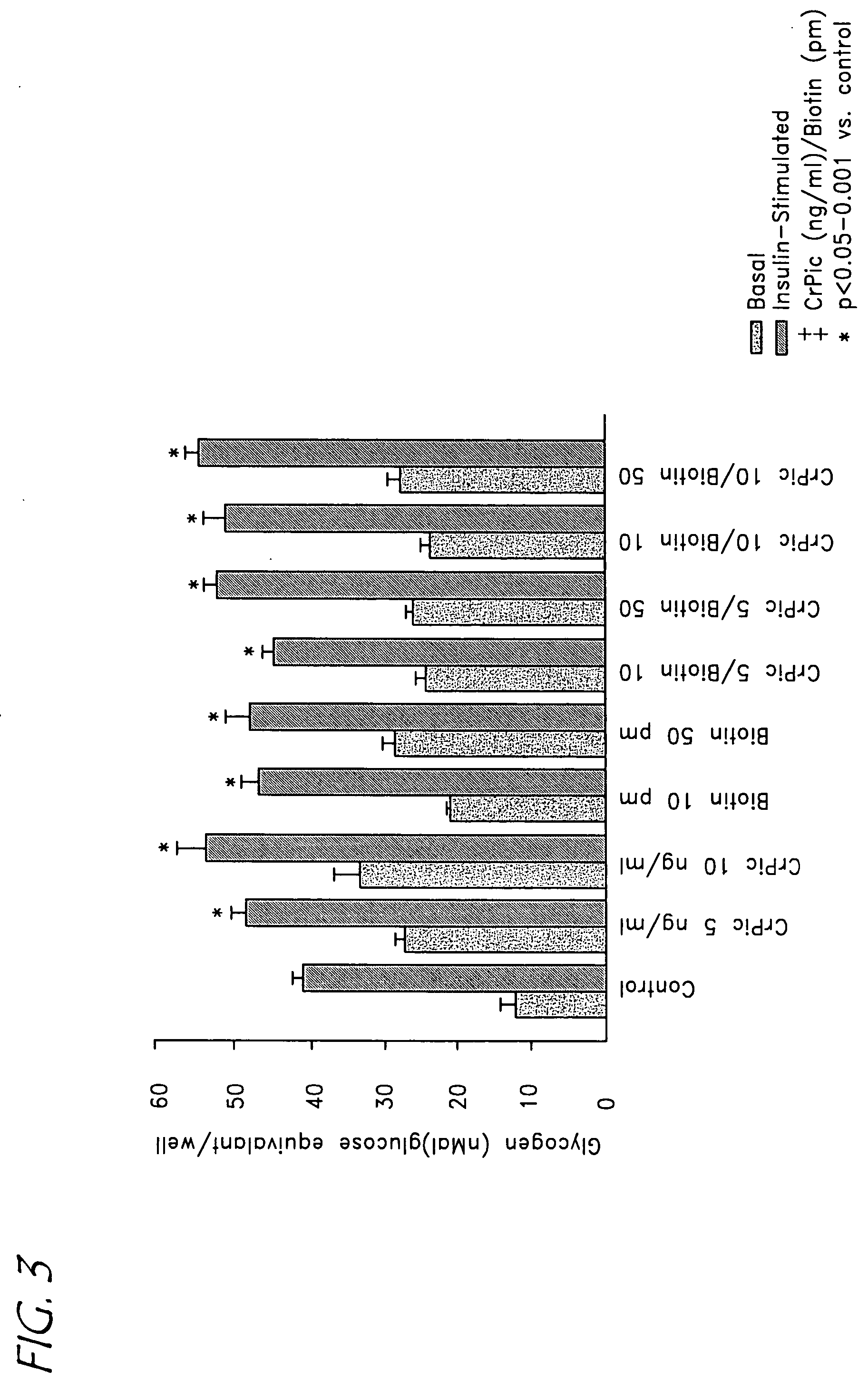Chromium/biotin treatment of dyslipidemia and diet-induced post prandial hyperglycemia
- Summary
- Abstract
- Description
- Claims
- Application Information
AI Technical Summary
Benefits of technology
Problems solved by technology
Method used
Image
Examples
example 1
Effects of Chromium and Biotin on Insulin Sensitivity
[0101] To evaluate the potential cellular mechanism for CrPic's in vivo effect, the role of chromium was evaluated, as monotherapy and in combination with biotin, on glucose uptake in a human skeletal muscle culture (“HSMC”). The value of the HSMC has been reported as representative of an insulin sensitive target tissue and skeletal muscle is the major tissue for glucose disposal in humans. See Henry, R. R. et al. Acquired defects of glycogen synthase activity in cultured human skeletal muscle cells: influence of high glucose and insulin levels. Diabetes, 45: 400-407 (1996).
[0102] With specific regard to glucose uptake, we have demonstrated that chromium alone enhances glucose uptake in contrast to biotin alone. However, when the HSMC was incubated with both, a synergistic effect on glucose uptake was observed as illustrated in FIG. 2. This observation was further extended to the assessment of glucogen synthesis. The human skele...
example 2
Evaluation of the Cellular Mechanism by Which CrPic and Biotin Enhance Glycogen Synthesis
[0103] To evaluate the cellular mechanism by which CrPic and biotin enhance glycogen synthesis, glycogen synthetase (“GS”) mRNA and glycogen synthesis were assessed. HSMC was incubated with CrPic at 10 ng / ml, biotin at 10 pm, and both CrPic and biotin. As demonstrated, CrPic and biotin were again observed to enhance insulin stimulated glycogen synthesis as depicted in FIG. 4A. When assessing gene expression, the combination of CrPic and biotin was observed to enhance GS mRNA (see FIG. 4B). When evaluating GS mRNA levels, chromium increased gene expression of GS by 26%, biotin by 15%, and the combination by 33%. This strongly suggests a synergistic effect of chromium and biotin on GS gene expression.
[0104] The mechanism proposed is that CrPic and biotin affect the rate of gene transcription of enzymes (particularly GS) involved in mediating the biologic effects of insulin in human skeletal musc...
example 3
Effect of Chromium and Biotin on Insulin Sensitivity in an Animal Model
[0105] In order to test the effects of chromium and biotin, alone and in combination, on insulin sensitivity, a rodent model of “Syndrome X” was employed. Specifically, the JCR rat was utilized as it is a well-established model of obesity and insulin resistance. In addition, this model exhibits clinical components of the insulin resistance syndrome (e.g., dyslipidemia, central obesity).
[0106] After a baseline phase where accurate weights, body composition, and food intake were assessed, the animals were randomized to either control, CrPic alone, biotin alone, or CrPic / Biotin (See FIG. 5). Animals were weighed weekly and nutrients were given via daily water feeding at a specified dose / kg body weight. A 12-week period of daily treatment of animals was accomplished.
Methods
[0107] At specified time points during the study, glucose and insulin assessments were made. Specific assessments of carbohydrate metabolism ...
PUM
| Property | Measurement | Unit |
|---|---|---|
| Mass | aaaaa | aaaaa |
| Mass | aaaaa | aaaaa |
| Mass | aaaaa | aaaaa |
Abstract
Description
Claims
Application Information
 Login to View More
Login to View More - R&D
- Intellectual Property
- Life Sciences
- Materials
- Tech Scout
- Unparalleled Data Quality
- Higher Quality Content
- 60% Fewer Hallucinations
Browse by: Latest US Patents, China's latest patents, Technical Efficacy Thesaurus, Application Domain, Technology Topic, Popular Technical Reports.
© 2025 PatSnap. All rights reserved.Legal|Privacy policy|Modern Slavery Act Transparency Statement|Sitemap|About US| Contact US: help@patsnap.com



